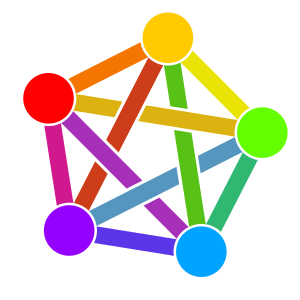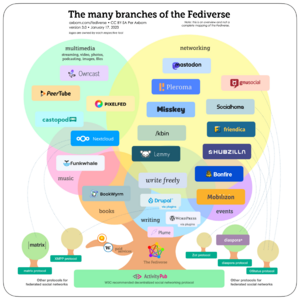Fediverse facts for kids
The Fediverse (short for fedi) is like a big neighborhood of different social media websites that can all talk to each other. Imagine if you could send messages from one app, like Instagram, directly to someone using another app, like TikTok! That's kind of how the Fediverse works. Users on different websites can share updates, pictures, videos, and other things across this network. The name "Fediverse" comes from combining "federation" (meaning different groups working together) and "universe."
Most Fediverse platforms use free and open-source software. They connect their servers using a special set of rules called the ActivityPub protocol. Some older platforms might still use other ways to connect, like OStatus.
Contents
How the Fediverse Works
Regular social media sites keep all their content on servers owned by one company. But the Fediverse is different because it's decentralized. This means anyone can host a social platform using their own computers, called an "instance."
Each instance is independent and can have its own rules. But just like how you can email someone using Gmail even if you use Outlook, people on different Fediverse instances can still see and interact with each other's content. For example, a user on one Mastodon instance can see and reply to posts from a user on a different Mastodon instance.
Even different types of social media services can talk to each other. A user on a microblogging site like Misskey can see and interact with posts from Mastodon users. Some Fediverse networks even let you interact with different social media styles from the same platform. For instance, someone on a news-sharing site like Lemmy can interact with posts from a similar service called mbin, and even with short updates from Mastodon.
Keeping Users Safe Online
Because the Fediverse is decentralized, keeping users safe and moderating content can be tricky. The people who run each instance are responsible for what's posted there. There's no single company in charge of the whole Fediverse. This means an instance can't be "removed" from the Fediverse entirely. Instead, other instances can choose to stop connecting with it, making its content unavailable to their users.
Each instance sets its own rules for content. Moderators on a Fediverse instance have to look at content from their own users and also from users on other instances.
Studies have shown that it can be harder for Fediverse instance operators to moderate content compared to big social media companies. This is because they might not have the same tools or legal reasons to do so. Solutions have been suggested to improve safety, like creating shared lists of bad content or better tools for moderators. Legal changes have also been discussed to encourage instance operators to moderate their connections more carefully.
History of the Fediverse
The idea of the Fediverse existed even before the ActivityPub protocol and the name "Fediverse" became popular. One of the first projects was Laconica, a microblogging platform. It used the OpenMicroBlogging protocol to let different installations of the software talk to each other. Laconica later became StatusNet in 2009, and then joined the GNU social project in 2013.
Over time, the OpenMicroBlogging protocol showed its limits because it was mostly for one-way text messages. To improve this, OStatus was created as an open standard for microblogging. It combined several technologies to allow instances to communicate. StatusNet started using OStatus in 2010, and OStatus quickly became very popular.
Around the same time, the diaspora* social network started, using its own way of connecting. To show the differences, people started using the terms "the Fediverse" and "the federation" more often after 2017. "The Fediverse" usually meant networks using OStatus, like GNU Social and Mastodon. "The federation" was often used for the competing diaspora* network.
ActivityPub: The Main Protocol
In 2012, the main StatusNet site, identi.ca, switched to new software called pump.io. This new software had a different way of connecting that was more flexible than OStatus. It was designed for general "activity streams" (like all kinds of updates, not just short messages). This new protocol influenced the development of ActivityPub.
In January 2018, the W3C (a group that sets internet standards) officially recommended the ActivityPub protocol. This standard aimed to make it easier for different software programs on many servers to work together. It was meant to replace OStatus and Pump.io. By 2019, almost all software that used OStatus also supported ActivityPub. While Mastodon stopped supporting OStatus, other projects like Friendica kept it. Today, the term "Fediverse" mostly refers to the ActivityPub protocol and the software that uses it.
Who Uses the Fediverse?
It has taken some time for many people to join the Fediverse. This is partly because it can seem a bit complicated to use at first.
After Elon Musk bought Twitter in November 2022, many users looked for new social media homes. A lot of them moved to Mastodon, which was the most popular alternative to Twitter and part of the Fediverse. Because of this, big social networks like Threads, Tumblr, and Flipboard became interested in supporting the ActivityPub protocol. Flickr also showed interest.
In 2024, the local government of Stary Sącz in Poland started using its own PeerTube instance (a video sharing platform in the Fediverse) instead of YouTube. They said they did this to follow proper regulations. Also in 2024, VIVERSE, a metaverse platform by HTC Vive, added ActivityPub support to its chat feature. This lets users send direct messages to other Fediverse users.
Blogs and Websites
WordPress has an official plugin that connects WordPress blogs to the Fediverse. This means comments on a blog post can be exchanged with replies on a Fediverse instance. Automattic, the company behind WordPress, bought this plugin in March 2023, and it became available to all WordPress.com users in October 2023.
Ghost, another blogging platform, announced in April 2024 that it would also add Fediverse support using ActivityPub. This feature was highly requested by its users.
Microblogging Platforms
Automattic CEO Matt Mullenweg said in November 2022 that Tumblr was adding ActivityPub support. This was in response to users who found Mastodon too complex. After some delays, Automattic confirmed in January 2025 that the ActivityPub plugin for WordPress would likely be the main way Tumblr connects to the Fediverse.
When Threads was launched by Meta in July 2023, it was announced that it planned to support the ActivityPub protocol. By December 2023, some Meta employees started testing this connection. A plan for integrating ActivityPub into Threads was shared in January 2024.
Some Fediverse administrators, who signed a pledge called "Fedipact", have been hesitant to connect with Threads. They worry that Meta might try to take over the network or that Threads' moderation won't stop harmful content.
In March 2024, Threads launched a test version of its Fediverse support. This allowed Threads users to see how many Fediverse users liked their posts, and Fediverse users could see posts from Threads. On April 2, 2024, the official Threads account for President Joe Biden enabled this connection, making him the first President of the United States to have a presence on the Fediverse. In August 2024, Threads added the ability for its users to see replies from the Fediverse.
News Aggregators
In December 2023, Flipboard announced that it started connecting some of its profiles and magazines with the Fediverse. Flipboard had previously run its own Mastodon instance, flipboard.social, to test out the Fediverse.
Other Decentralized Networks
While the Fediverse is the most well-known example of decentralized social networks, there are other options. A major competitor is the AT Protocol, which powers the Bluesky social network. This network is sometimes called the Atmosphere. Smaller networks like Nostr and Farcaster are also popular, especially in the cryptocurrency community. These newer protocols work differently from ActivityPub, often by publishing content to special relays for sharing. Even with these differences, there is software that can "bridge" content between these different networks, allowing content to be shared across multiple protocols.
Fediverse Software
ActivityPub is the most widely used protocol in the Fediverse and is a standard set by the W3C. Some popular Fediverse software includes:
- Content Management Systems (for websites and blogs)
* Drupal (with an extra plugin) * WordPress (with an official plugin)
- Image and Video Sharing
* Pixelfed, for sharing pictures * PeerTube, for streaming videos
* Friendica
- Events
- Microblogging (short updates)
* Mastodon * Misskey * Pleroma
- Social News (for sharing and discussing links)
* Lemmy * mbin * PieFed
See also
 In Spanish: Fediverso para niños
In Spanish: Fediverso para niños




